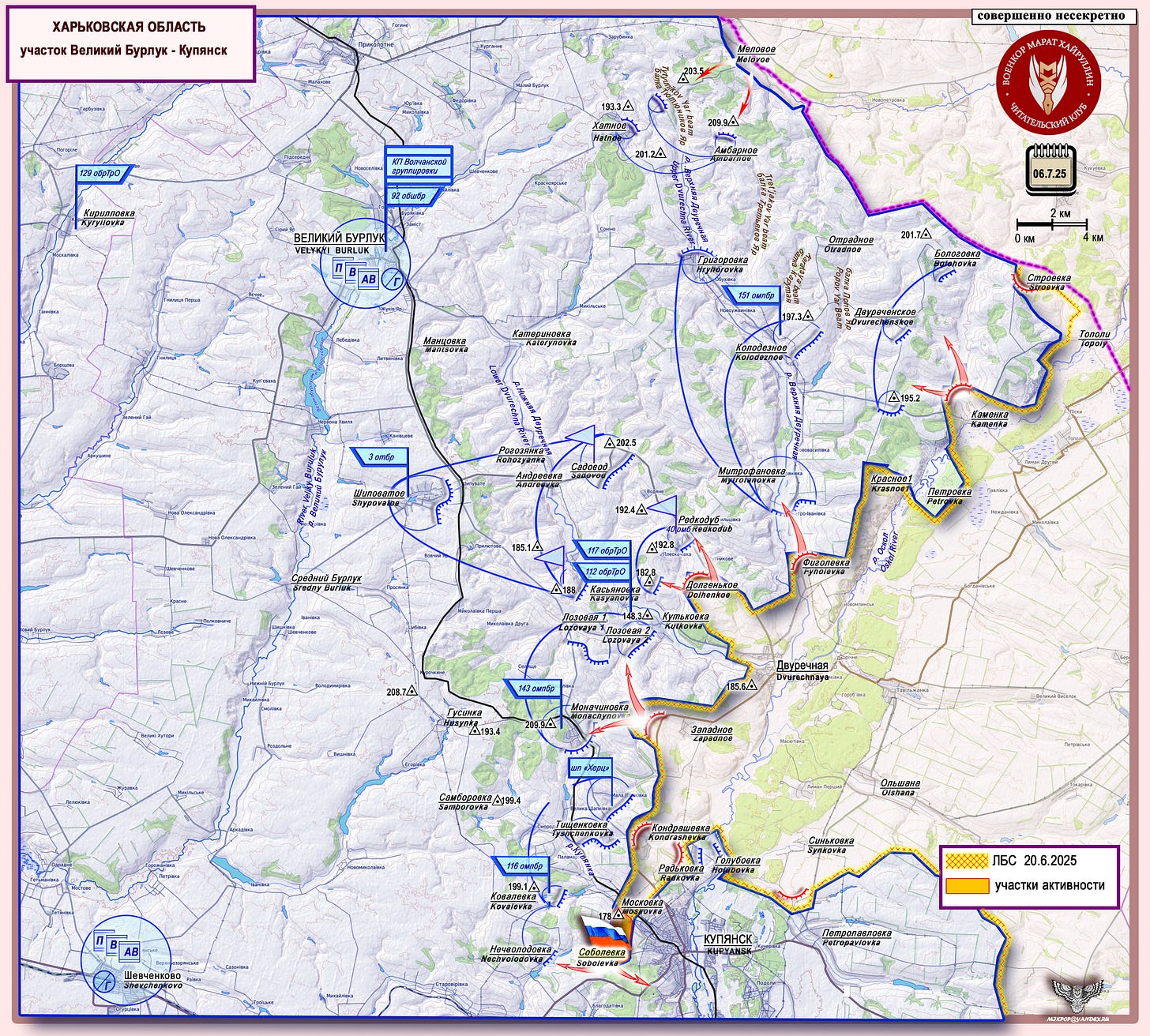The Russian Ministry of Defense reports: “Units of the "West" Group liberated the settlement of Sobolevka in the Kharkov region through decisive actions.”

The small village of Sobolevka (approximately 80 inhabitants) is located 2 kilometers west of Kupyansk. The settlement adjoins an oak forest area, while 1.5 km to the south runs the H-26 (P07 on western maps) highway connecting Kupyansk with Ukraine's rear areas, with a radial road branching off near Nechvolodovka north toward Velikaya Shapovka. Control of Sobolevka allows Russian forces to cut another supply route to the Kupyansk area and isolate the left flank of Ukrainian forces on the Kupyansk axis from coordination with central command.
This episode clearly demonstrates the methodology of the Russian General Staff for destabilizing Ukrainian defenses.
To recap the development of events on the Kupyansk axis during late May/June-early July (only key events):
🇷🇺 On May 23, the village of Radkovka was liberated, creating a possibility of enveloping Kupyansk from the north.
🇷🇺 On May 30, this success was consolidated, and the operational area expanded through liberation of Kondrashevka, thereby securing the right flank for further operations.
🇷🇺 On June 4, preventing enemy reserves from maneuvering toward the northern advance, movement began southward on the Ukrainian forces' right flank, resulting in liberation of Redkodub.
🇷🇺 On June 18, countering Ukrainian maneuvers near Redkodub, activity increased on the northern sector with the liberation of Dolgenkoye (Dolhenkoe), threatening to split Ukrainian forces' left flank on the Kupyansk axis.
🇷🇺 On June 20, as Ukrainian forces began countering our success near Dolgenkoye, a strike was delivered on the main axis (north of Kupyansk) liberating Moskovka (Myrnoe).
🇷🇺 On June 22, Russian forces again shifted activity to the southern axis, liberating Petrovskoye (Grekovka, not on either of these maps; it's further south near Makeevka).
🇷🇺 On June 27, liberation of Novaya Kruglyakovka (also not on these maps, south of the Kupyansk area, near Borovaya) created a threat to AFU crossings over the Oskol River, forcing the Ukrainian command to reinforce this area.
🇷🇺 On July 3, a sharp escalation occurred on the Kharkov axis supporting Kupyansk - (Map above, top middle, near the top edge of the map) the liberation of Melovoye and the establishment of a highly advantageous bridgehead in an area that was previously only lightly defended by Ukrainian forces. The enemy was forced to commit already limited reserves to secure this sector, and as soon as they began this maneuver...
🇷🇺 On July 6, a deep enveloping strike was launched into Kupyansk's rear, resulting in liberation of Sobolevka.
For Russian forces, this was a rather risky operation given the narrow advance corridor and potential for Ukrainian strikes against the extended grouping's flanks. Our command could only take such action being confident in reliable flank security and the enemy's lack of capability/resources for counteractions.
This may well represent "Byzantine treachery" or "Mongolian lure" tactics - forcing the enemy to act quickly and reactively while keeping several surprises for them in reserve.
Chess players will recognize this tactic where any opponent's move worsens their position.
The Russian Ministry of Defense reports: "Through decisive operations, units of the 'East' Group have liberated the settlement of Poddubnoye in the Donetsk People's Republic."
This substantial village, with a population of approximately 800, represents another strategic gain in establishing a firm bridgehead on the west bank of the Mokrye Yaly (Mokrye Yaly) River at its westmost stretch.
Russian forces continue making steady progress in dismantling the elaborate Ukrainian defensive network situated at the confluence of five waterways: the Volchya (Wolf), Mokrye Yaly, Solenaya, Kamenka, and Voronaya rivers.
Current operational patterns suggest forthcoming Russian efforts will focus on expanding this bridgehead through clearing operations in Tolstoy and Myrnoe settlements, followed by westward advances toward Ukrainian defensive positions between Aleksandrograd and Voskresenka. This offensive pressure will likely continue until Ukrainian command is compelled to redeploy mobile reserve groups to stabilize the sector - reinforcements which can only be drawn from immediately adjacent areas given current force constraints.
The inevitable Ukrainian reinforcement will create opportunities elsewhere along the frontline. As soon as enemy units are diverted to shore up defenses near Poddubnoye, Russian forces will undoubtedly exploit weakened positions in other sectors through coordinated offensive actions.
The rapid pace at which Russian units are systematically dismantling these carefully prepared Ukrainian defensive positions speaks volumes about the current state of Ukraine's armed forces. While remaining dangerous and capable of fierce resistance, they have clearly lost the capacity to wrest operational initiative from Russian commanders. This strategic deficiency resembles an incurable medical condition - while temporary treatments may provide symptomatic relief and prolong the struggle, the ultimate outcome becomes inevitable. When the funeral director already has the patient's address in his records, no amount of medication can alter the final result.
The Ukrainian military continues fighting with intensity, but without the means to reverse the tactical momentum, their position grows increasingly precarious with each passing week of Russian advances. Current operations demonstrate Moscow's forces are now dictating the terms of engagement across multiple sectors of the frontline.






Excellent reports. Thank you from Bernard, 80 years old from southern France, still remembering the Great Patriotic War that liberated western Europe from the Nazis
I understand the chess analogy more than most being on the receiving end most of the time.
Orchestral manoeuvres in the dark.